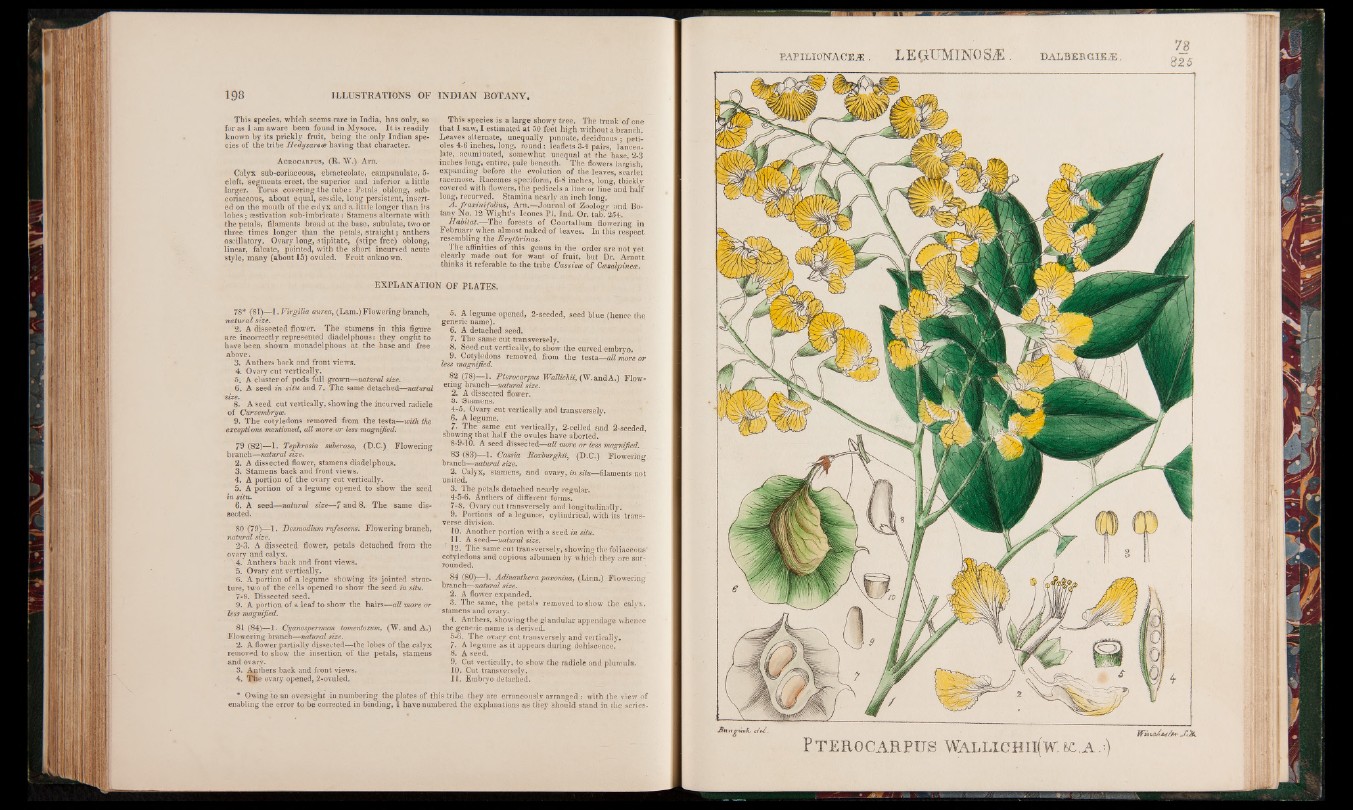
This species, which seems rare in India, has only, so
far as I am aware been found in Mysore. It is readily
known by its prickly fruit, being the only Indian species
of the tribe Hedysareas having that character.
Acrocarpus, (R. W.) Am.
Calyx sub-coriaceous, ebracteolate, campanulate, 5-
cleft, segments erect, the superior and inferior a little
larger. Torus covering the tube: Petals __ oblong, .sub-
coriaceous, about equal, sessile, long persistent, inserted
on the mouth of the calyx and a little longer than its
lobes; aestivation sub-imbricate: Stamens alternate with
the petals, filaments broad at the base, subulate, two or
three times longer than the petals, straight; anthers
oscillatory. Ovary long, stipitate, (stipe free) oblong,
linear, falcate, pointed, with the snort incurved acute
style, many (about 15) ovuled. Fruit unknown.
This species is a large showy tree. The trunk of one
that I saw, I estimated at 50 feet high without a branch.
Leaves alternate, unequally pinnate, deciduous ; petioles
4-6 inches, long, round: leaflets 3-4 pairs, lanceolate,
acuminated, somewhat unequal at the base, 2-3
inches long, entire, pale beneath. The flowers largish,
expanding before the evolution of the leaves, scarlet
racemose. Racemes speciform, 6-8 inches, long, thickly
covered with flowers, the pedicels a line or line and half
long, recurved. Stamina nearly an inch long.
A . fraxinifolius, Am.—Journal of Zoology and Botany
No, 12 Wight’s leones PI. Ind. Or. tab. 254.
Habitat.—The forests of Courtallum flowering in
February when almost naked of leaves. In this respect
resembling the Erythrinas.
The affinities of this genus in the order are not yet
clearly made out for want of fruit, but Dr. Arnott
thinks it referable to the tribe Cassiece of Ccesalpineee.
EXPLANATION OF PLATES.
78* (81)—I. Virgilia aurea, (Lam.) Flowering branch,
natural size.
'2. A dissected flower. The stamens'in this figure
are incorrectly represented diadelphous: they ought to
have been shown monadelphous at the base and free
above.
3. Anthers back and front views.
4. Ovary cut vertically.
5. A cluster of pods full grown—natural size. -
6. A seed in situ and 7. The same detached—natural
size.
8. A seed cut vertically, showing the incurved radicle
of Cvrvenibryce.
9. The cotyledons removed from the testa—with the
exceptions mentioned, all more or less magnified.
79 (82)—1. Tephrosia suberosa, (D.C.) Flowering
branch—natural size.
2. A dissected flower, stamens diadelphous.
3. Stamens back and front views.
4. A portion of the ovary cut vertically.
5. A portion of a legume opened to show the seed
in situ.
6. A seed—natural size—7 and 8. The same dissected.
80 (79)—1. Desmodiumrufescens. Flowering branch,
natural size.
2-3. A dissected flower, petals detached from the
ovary and calyx.
4. Anthers back and front views.
5. Ovary cut vertically.
6. A portion of a legume showing its jointed structure,
two o f the cells opened to show the seed in situ.
7-8. Dissected seed.
9. A portion of a leaf to show the hairs—all more or
less magnified.
81 (84)— 1. Cyanospermum tomentosum, (W. and A.)
Flowering branch—natural size.
2. A flower partially dissected—the lobes of the calyx
removed to show the insertion of the petals, stamens
and ovary.
3. Anthers back and front views.
4. Tiie ovary opened, 2-ovuled.
5. A legume opened, 2-seeded, seed blue (hence the
generic name).
6. A detached seed.
7. The same cut transversely.
8. Seed cut vertically, to show the curved embryo.
9. Cotyledons removed from the testa—all more or
less magnified.
82 (78)—1. Pterocarpus Wallichii, (W.andA.) Flowering
branch—natural size.
2. A dissected flower.
8. Stamens.
4-5. Ovary cut vertically and transversely.
6. A legume.
7. The same cut' vertically, 2-celled and 2-seeded,
showing that half the ovules have aborted.
8-9-10. A seed dissected—all more or less magnified.
83 (83)—1. Cassia RoxburgMi, (D.C.) Flowering,
branch—natural size.
2. Calyx, stamens, and ovary, in situ—filaments not
united.
3. The petals detached nearly regular.
4- 5-6. Anthers of different forms.
7-8. Ovary cut transversely and longitudinally.
9. Portions of a legume, cylindrical, with its transverse
division.
10. Another portion with a seed in situ.
r 11. A seed—natural size.
12. The same cut transversely, showing the foliaceous'
cotyledons and copious albumen by which they are surrounded.
84 (80)—l. Adinanthera pavonina, (Lir.n.) Flowering
branch—natural size.
2. A flower expanded.
3. The same, the petals removed to show the calyx,
stamens and ovary.
4. Anthers, showing the ,glandular appendage whence
the generic name is derived.
5- 6. The ovary cut transversely and vertically.
7. A legume as it appears during dehiscence.
8. A seed.
9. Cut vertically, to show the radicle and plumula.
10. Cut transversely.
11. Embryo detached.
* Owing to an oversight in numbering the plates of this tribe they are erroneously arranged: with the view of
enabling the error to be corrected in binding, I have numbered the explanations as they should stand in the series.
EAPiLioNÀCEÆ. L E GUMINO SÆ DALBERGIEÆ.
78
8 2 5
A ,r ,gmk. JU .
P t e r o c a r p u s m L L icH ii(w . tc.a .*)